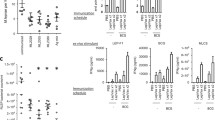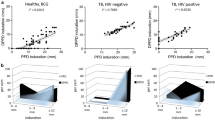Abstract
The persistence of new leprosy cases in endemic areas such as India, Brazil, Bangladesh, and the Philippines has encouraged studies of chemoprophylaxis among contacts of patients. Epidemiological screening tools to enable early detection of infected individuals in endemic populations would be critical to target individuals most in need of intervention. Despite decades of attempts, however, there still are no tests available for the early detection of low-level infection with Mycobacterium leprae. In this report, we describe the development of a leprosy skin test using M. leprae-specific antigens. We selected the chimeric LID-1 fusion protein, formulated to achieve maximum performance at a minimal dose, as a skin test candidate based on its ability to elicit delayed-type hypersensitivity (DTH) reactions in M. leprae immune guinea pigs in a sensitive and specific manner, i.e., with no cross-reactivity observed with other mycobacterial species. Importantly, evaluations in armadillos indicated that intradermal inoculation of formulated LID-1 could distinguish uninfected from M. leprae-infected animals manifesting with symptoms distinctly similar to the PB presentation of patients. Together, our data provide strong proof-of-concept for developing an antigen-specific skin test to detect low-level M. leprae infection. Such a test could, when applied with appropriate use of chemo- and/or immunoprophylaxis, be instrumental in altering the evolution of clinical disease and M. leprae transmission, thus furthering the objective of zero leprosy.




Similar content being viewed by others
References
Bass JB Jr (2003) How good is the tuberculin skin test? Infect Control Hosp Epidemiol 24(11):797–798. https://doi.org/10.1086/502138
Cameron MM, Acosta-Serrano A, Bern C, Boelaert M, den Boer M, Burza S, Chapman LA, Chaskopoulou A, Coleman M, Courtenay O, Croft S, Das P, Dilger E, Foster G, Garlapati R, Haines L, Harris A, Hemingway J, Hollingsworth TD, Jervis S, Medley G, Miles M, Paine M, Picado A, Poche R, Ready P, Rogers M, Rowland M, Sundar S, de Vlas SJ, Weetman D (2016) Understanding the transmission dynamics of Leishmania donovani to provide robust evidence for interventions to eliminate visceral leishmaniasis in Bihar, India. Parasit Vectors 9:25. https://doi.org/10.1186/s13071-016-1309-8
Cardoso LP, Dias RF, Freitas AA, Hungria EM, Oliveira RM, Collovati M, Reed SG, Duthie MS, Stefani MM (2013) Development of a quantitative rapid diagnostic test for multibacillary leprosy using smart phone technology. BMC Infect Dis 13(1):497. https://doi.org/10.1186/1471-2334-13-497
Convit J, Sampson C, Zuniga M, Smith PG, Plata J, Silva J, Molina J, Pinardi ME, Bloom BR, Salgado A (1992) Immunoprophylactic trial with combined Mycobacterium leprae/BCG vaccine against leprosy: preliminary results. Lancet 339(8791):446–450
de Souza MM, Netto EM, Nakatani M, Duthie MS (2014) Utility of recombinant proteins LID-1 and PADL in screening for Mycobacterium leprae infection and leprosy. Trans R Soc Trop Med Hyg 108(8):495–501. https://doi.org/10.1093/trstmh/tru093
Dharmendra (2012) The immunological skin tests in leprosy. Part I. The isolation of a protein antigen of Mycobacterium leprae. 1942. Indian J Med Res 136(3):7 following 502
Duthie MS, Balagon MF, Maghanoy A, Orcullo FM, Cang M, Dias RF, Collovati M, Reed SG (2014a) Rapid quantitative serological test for detection of infection with Mycobacterium leprae, the causative agent of leprosy. J Clin Microbiol 52(2):613–619. https://doi.org/10.1128/JCM.02085-13
Duthie MS, Coler RN, Laurance JD, Sampaio LH, Oliveira RM, Sousa AL, Stefani MM, Maeda Y, Matsuoka M, Makino M, Reed SG (2014b) Protection against Mycobacterium leprae infection by the ID83/GLA-SE and ID93/GLA-SE vaccines developed for tuberculosis. Infect Immun 82(9):3979–3985. https://doi.org/10.1128/IAI.02145-14
Duthie MS, Goto W, Ireton GC, Reece ST, Sampaio LH, Grassi AB, Sousa AL, Martelli CM, Stefani MM, Reed SG (2008) Antigen-specific T-cell responses of leprosy patients. Clin Vaccine Immunol 15(11):1659–1665. https://doi.org/10.1128/CVI.00234-08
Duthie MS, Orcullo FM, Abbelana J, Maghanoy A, Balagon MF (2016a) Comparative evaluation of antibody detection tests to facilitate the diagnosis of multibacillary leprosy. Appl Microbiol Biotechnol 100(7):3267–3275. https://doi.org/10.1007/s00253-016-7328-8
Duthie MS, Orcullo FM, Maghanoy A, Balagon M (2016b) Need for, and acceptability of, rapid diagnostic tests that can facilitate the diagnosis of leprosy. Leprosy Review in press
Duthie MS, Pena MT, Ebenezer GJ, Gillis TP, Sharma R, Cunningham K, Polydefkis M, Maeda Y, Makino M, Truman RW, Reed SG (2018) LepVax, a defined subunit vaccine that provides effective pre-exposure and post-exposure prophylaxis of M. leprae infection. NPJ Vaccines 3:12. https://doi.org/10.1038/s41541-018-0050-z
Duthie MS, Raychaudhuri R, Tutterrow YL, Misquith A, Bowman J, Casey A, Balagon MF, Maghanoy A, Beltran-Alzate JC, Romero-Alzate M, Cardona-Castro N, Reed SG (2014c) A rapid ELISA for the diagnosis of MB leprosy based on complementary detection of antibodies against a novel protein-glycolipid conjugate. Diagn Microbiol Infect Dis 79(2):233–239. https://doi.org/10.1016/j.diagmicrobio.2014.02.006
Duthie MS, Sampaio LH, Oliveira RM, Raman VS, O'Donnell J, Bailor HR, Ireton GC, Sousa AL, Stefani MM, Reed SG (2013) Development and pre-clinical assessment of a 73 kD chimeric fusion protein as a defined sub-unit vaccine for leprosy. Vaccine 31(5):813–819. https://doi.org/10.1016/j.vaccine.2012.11.073
Dye C, Glaziou P, Floyd K, Raviglione M (2013) Prospects for tuberculosis elimination. Annu Rev Public Health 34:271–286. https://doi.org/10.1146/annurev-publhealth-031912-114431
Frade MA, de Paula NA, Gomes CM, Vernal S, Bernardes Filho F, Lugao HB, de Abreu MM, Botini P, Duthie MS, Spencer JS, Soares RC, Foss NT (2017) Unexpectedly high leprosy seroprevalence detected using a random surveillance strategy in midwestern Brazil: a comparison of ELISA and a rapid diagnostic test. PLoS Negl Trop Dis 11(2):e0005375. https://doi.org/10.1371/journal.pntd.0005375
Job CK, Kirchheimer WF, Sanchez RM (1983) Variable lepromin response to Mycobacterium leprae in resistant armadillos. Int J Lepr Other Mycobact Dis 51(3):347–353
Job CK, Truman RW (2000) Comparative study of Mitsuda reaction to nude mouse and armadillo lepromin preparations using nine-banded armadillos. Int J Lepr Other Mycobact Dis 68(1):18–22
Loughry WJ, Truman RW, McDonough CM, Tilak MK, Garnier S, Delsuc F (2009) Is leprosy spreading among nine-banded armadillos in the southeastern United States? J Wildl Dis 45(1):144–152
Marques MA, Neves-Ferreira AG, da Silveira EK, Valente RH, Chapeaurouge A, Perales J, da Silva BR, Dobos KM, Spencer JS, Brennan PJ, Pessolani MC (2008) Deciphering the proteomic profile of Mycobacterium leprae cell envelope. Proteomics 8(12):2477–2491. https://doi.org/10.1002/pmic.200700971
Meyers WM, Kvernes S, Binford CH (1975) Comparison of reactions to human and armadillo lepromins in leprosy. Int J Lepr Other Mycobact Dis 43(3):218–225
Millar JW, Gannon C, Chan CS (1975) Comparison in leprosy patients of Fernandex and Mitsuda reactions using human and armadillo antigens. A double-blind study. Int J Lepr Other Mycobact Dis 43(3):226–233
Richardus JH, Habbema JD (2007) The impact of leprosy control on the transmission of M. leprae: is elimination being attained? Lepr Rev 78(4):330–337
Ridley DS, Jopling WH (1966) Classification of leprosy according to immunity. A five-group system. Int J Lepr Other Mycobact Dis 34(3):255–273
Rivoire BL, Groathouse NA, TerLouw S, Neupane KD, Ranjit C, Sapkota BR, Khadge S, Kunwar CB, Macdonald M, Hawksworth R, Thapa MB, Hagge DA, Tibbals M, Smith C, Dube T, She D, Wolff M, Zhou E, Makhene M, Mason R, Sizemore C, Brennan PJ (2014a) Safety and efficacy assessment of two new leprosy skin test antigens: randomized double blind clinical study. PLoS Negl Trop Dis 8(5):e2811. https://doi.org/10.1371/journal.pntd.0002811
Rivoire BL, TerLouw S, Groathouse NA, Brennan PJ (2014b) The challenge of producing skin test antigens with minimal resources suitable for human application against a neglected tropical disease; leprosy. PLoS Negl Trop Dis 8(5):e2791. https://doi.org/10.1371/journal.pntd.0002791
Rodrigues LC, Lockwood D (2011) Leprosy now: epidemiology, progress, challenges, and research gaps. Lancet Infect Dis 11(6):464–470. https://doi.org/10.1016/S1473-3099(11)70006-8
Roset Bahmanyar E, Smith WC, Brennan P, Cummings R, Duthie M, Richardus JH, Saunderson P, Shwe T, Rosen S, Geluk A (2016) Leprosy diagnostic test development as a prerequisite towards elimination: requirements from the user's perspective. PLoS Negl Trop Dis 10(2):e0004331. https://doi.org/10.1371/journal.pntd.0004331
Sachdeva S, Amin SS, Khan Z, Sharma PK, Bansal S (2011a) Childhood leprosy: lest we forget. Trop Dr 41(3):163–165. https://doi.org/10.1258/td.2011.100477
Sachdeva S, Khan Z, Ansari MA, Amin SS (2011b) Leprosy: down but not out. Trop Dr 41(1):28–30. https://doi.org/10.1258/td.2010.100107
Sampaio LH, Stefani MM, Oliveira RM, Sousa AL, Ireton GC, Reed SG, Duthie MS (2011) Immunologically reactive M. leprae antigens with relevance to diagnosis and vaccine development. BMC Infect Dis 11:26. https://doi.org/10.1186/1471-2334-11-26
Scollard DM (2004) Classification of leprosy: a full color spectrum, or black and white? Int J Lepr Other Mycobact Dis 72(2):166–168
Scollard DM (2008a) The biology of nerve injury in leprosy. Lepr Rev 79(3):242–253
Scollard DM (2008b) Leprosy is (still) here, but recognition is often delayed. South Med J 101(6):583. https://doi.org/10.1097/SMJ.0b013e318172e077
Scollard DM, Adams LB, Gillis TP, Krahenbuhl JL, Truman RW, Williams DL (2006) The continuing challenges of leprosy. Clin Microbiol Rev 19(2):338–381
Sharma R, Lahiri R, Scollard DM, Pena M, Williams DL, Adams LB, Figarola J, Truman RW (2013) The armadillo: a model for the neuropathy of leprosy and potentially other neurodegenerative diseases. Dis Model Mech 6(1):19–24. https://doi.org/10.1242/dmm.010215
Singal A, Sonthalia S, Pandhi D (2011) Childhood leprosy in a tertiary-care hospital in Delhi, India: a reappraisal in the post-elimination era. Lepr Rev 82(3):259–269
Snider DE Jr (1982) The tuberculin skin test. Am Rev Respir Dis 125(3 Pt 2):108–118. https://doi.org/10.1164/arrd.1982.125.3P2.108
Storrs EE, Walsh GP, Burchfield HP, Binford CH (1974) Leprosy in the armadillo: new model for biomedical research. Science 183(127):851–852
Truman RW, Ebenezer GJ, Pena MT, Sharma R, Balamayooran G, Gillingwater TH, Scollard DM, McArthur JC, Rambukkana A (2014) The armadillo as a model for peripheral neuropathy in leprosy. ILAR J 54(3):304–314. https://doi.org/10.1093/ilar/ilt050
Van Brakel WH, Nicholls PG, Das L, Barkataki P, Maddali P, Lockwood DN, Wilder-Smith E (2005) The INFIR cohort study: assessment of sensory and motor neuropathy in leprosy at baseline. Lepr Rev 76(4):277–295
WHO (2010) Enhanced global strategy for further reducing the disease burden due to leprosy: 2011–2015. World Health Organization Geneva
Acknowledgments
We thank Richard Cabullos and Raodoh Mohamath for technical assistance producing the antigens used.
Funding
This research was conducted under NIH SBIR contract HHSN272201800019C, along with grants from the American Leprosy Missions, and an interagency agreement AAI15006 between the US Department of Health and Human Services Health Resources and Services Administration (HRSA) and NIAID. The funders had no input to the production of this manuscript, and the opinions provided are the authors’ own.
Author information
Authors and Affiliations
Corresponding author
Ethics declarations
Conflict of interest
All authors declare that they have no conflict of interest.
Ethical approval
All applicable international, national, and/or institutional guidelines for the care and use of animals were followed.
Additional information
Publisher’s note
Springer Nature remains neutral with regard to jurisdictional claims in published maps and institutional affiliations.
Electronic supplementary material
ESM 1
(PDF 199 kb)
Rights and permissions
About this article
Cite this article
Duthie, M.S., Pena, M.T., Khandhar, A.P. et al. Development of LepReact, a defined skin test for paucibacillary leprosy and low-level M. leprae infection. Appl Microbiol Biotechnol 104, 3971–3979 (2020). https://doi.org/10.1007/s00253-020-10505-2
Received:
Revised:
Accepted:
Published:
Issue Date:
DOI: https://doi.org/10.1007/s00253-020-10505-2




